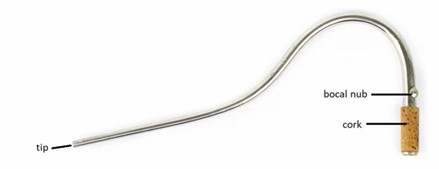
Take Care:
Things to know:
- Always hold the bocal as close to the cork as possible, NOT at the tip where the reed fits.
- The cork needs to be secure and in good shape. A loose cork will tear, and any missing pieces of cork will create a leak. Any leak will make response, intonation, and tone challenging if not impossible.
- The bocal needs to be free of dents and creases. As with leaks, any dent or crease can make playing with good response, intonation, and tone difficult.
- The shape of the bocal plays a role in determining the angle at which the reed enters the mouth. If the bocal has a very steep downward slant from the curved part to the tip, the player will need to rest the boot closer to the hip than the knee to minimize the downward angle of the reed as it enters the mouth.
- Avoid putting the tip end of the bocal into the wing joint. It can scratch the bore of the wing joint and/or bend the bocal.
THE SEAT STRAP
The seat strap supports the weight of the instrument, allowing the hands and fingers to move without having to support the weight of the bassoon. There are several different styles of seat strap, and the three most common styles are described below.

Simple leather strap with a closed clip on one end. The strap must be moved to raise and lower the height of the bassoon.

Adjustable leather strap. The adjustment mechanism allows the player to sit still while adjusting the height of the bassoon.

Leather strap with an adjustable cup at one end. The strap must be moved to raise and lower the height of the bassoon.
The first two straps pictured above have a hook that will connect through a metal ring or feed through a hole at the bottom of the boot joint.

With a cup-style strap, the boot cap at the bottom of the boot joint will sit inside of the adjustable leather cup.

*TIP: If using a clip-style strap, feed a sturdy keyring through the hole or loop on the bottom of the boot cap. This will make the point of connection between the strap and the boot joint more flexible.

Things to know about the seat strap:
- The seat strap should be the first thing taken out of the case and put on the chair. This will keep the player from having to juggle the assembled bassoon while putting the seat strap in place.
- Place the seat strap on the chair with the hook or cup hanging off the right side of the chair (close to where the player’s right knee will be when seated).
- The height of the bassoon – where the reed comes to when the bassoon is in playing position and the reed is on the bocal – is adjusted by increasing or decreasing the amount of seat strap that extends beyond the right side of the player.
- If the bassoon is too low (if the reed comes to a place below your lips), move the seat strap to the left by pulling on the left-side end of the strap.
- If the bassoon is too high (if the reed comes to a place above your lips), move more of the strap to the right by carefully shifting your weight off of the strap and letting it slide to your right.
- The strap needs to be long enough to hang off the left side of the chair, within easy reach of the player’s left hand.
- Proper positioning of the seat strap will allow the player to hold the instrument in a balanced, comfortable position.
- Improper positioning of the seat strap will make the bassoon difficult to hold and may prevent lower keys on the boot joint from operating correctly.

Feedback/Errata